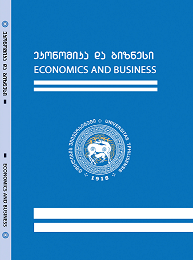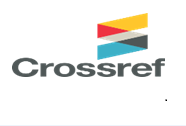
Referential and Reviewed International Scientific-Analytical Journal of Ivane Javakhishvili Tbilisi State University, Faculty of Economics and Business


„ECONOMICS and BUZINESS“ VOLUM XVII, N2, 2025
C O N T E N T
ECONOMIC THEORY ◊ ECONOMIC POLICY
Tamaz Zubiashvili - Contemporary world Urbanization: Dynamics and Challanges
Rusudan Sirbiladze - Georgia-US Economic Relations (Current Status and Prospects)
Mariam Khorava - Contemporary Geopolitical Reality and Its Impact on Georgia’s
Economic Development
Elene Kobakhidze - The Circular Economy: A New Paradigm for Sustainable Development
Luka Tsertsvadze - The Impact of the Information and Communication Technology (ICT) Sector on Economic Growth
BUSINESS ◊ MANAGEMENT ◊ MARKETING ◊ TOURISM
Ioseb Khelashvili, Mariam Sharia - Economic Impact of Tourism Industry Development in Georgia: Current Trends
Maia Kheladze, David Sikharulidze, David Dzidzikashvili - AI-Driven Business
Models in the Payment Industry and the Impact of Cashless Payments on Economic Growth in Georgia
Nana Shashiashvili, Zaza Sopromadze, Besarion Simonishvili - Sales Techniques for Medical Products and Key Account Management
Lali Kipshidze - Shaping the Future of Georgia’s Healthcare Business: Market Trends, Development Strategies, and Revenue Diversification
FINANCE and BANKING ◊ ACCAUNTING and AUDIT
Levan Sabauri - Challenges in Preparing Sustainable Development Reports by Small and Medium-Sized Enterprises (SMEs) in Georgia: A Comparative Analysis with Armenia and Azerbaijan
Tengiz Verulava, Revaz Jorbenadze, Giorgi Kurtanidze - Introduction of the Similar
Diagnosis-Based Financing Method in Georgia and Its Impact on the Efficiency of Medical Services
Tamila Kartsivadze - The Impact of Digital Currencies on Exchange Rates
Nikoloz Dadiani - Price Formation in Construction Across Western Countries and Georgia
Eka Gegeshidze, Natia Kalatozishvili - Accounting Reforms and Access to Finance for Small and Medium Enterprises (SMEs) in Developing Economies (The Case of Georgia)
News
Presentation of the Book Dedicted to the 70th Anniversary of Academician Vladimer Papava
Academician Avtandil Silagadze Honored with Prestigious Award
2025-10-10
Contemporary World Urbanization: Dynamics and Challenges
doi.org/10.52340/eab.2025.17.03.01 journal N 3.2025 Urbanization, a complex and multifaceted phenomenon, has significant impli- cations for both developed and developing countries. While it presents opportuni- ties such as economic growth and innovation, it also poses numerous challenges. In developing countries, rapid urban population growth, driven by natural increase and migration, has led to overcrowded cities with inadequate infrastructure, exac- erbating issues like poverty, environmental degradation, and public health crises. The variability in defining urban populations and the lack of reliable income data further complicate poverty measurement and mitigation efforts.In developed countries, urban challenges include an aging population, decen- tralization, and immigration, requiring effective management of ethnic diversity and resources. Large cities contribute to environmental issues like global warming and air pollution, necessitating sustainable urban planning. Concerns2025-10-10
Georgia – US Economic Relations (Current Status and Prospects)
doi.org/10.52340/eab.2025.17.03.02 In studying the economy, it is essential to engage with reality – examining what is truly occurring both within the domesticsphere and in the broader context of international integration. Our research explores contemporary economic processes alongside emerging perspectives shaped by global interconnectedness. Economic existence, as we understand, is transmitted across generations. According to the Holy Scriptures, God created man in His image within the visible world, appointing him as steward over the creatures. He endowed humanity with freedom and bestowed a unique dignity, entrusting individuals with the moral responsibility to choose between good and evil, life and death – decision left to the discretion of free will. The nature of life, its security, and the fulfillment of ever-evolving human needs ultimately depend on individual agency. Economics provides a lens through which we understand how to align our developed needs2025-10-10
Contemporary Geopolitical Reality and Its Impact on Georgia s Economic Development
doi.org/10.52340/eab.2025.17.03.03 Georgia’s geopolitical position between Russia, Turkey, and the European Union (EU) has long shaped its economic and political trajectory. Since regaining independence from the Soviet Union in 1991, the country has actively pursued economic modernization, integration with Western institutions, and infrastructure development. However, regional conflicts, shifting alliances, and global economic fluctuations continue to impact Georgia’s development.The post-Soviet economic transition was characterized by structural reforms, privatization, and policy shifts aimed at establishing a market-driven economy. Georgia’s aspirations toward Euro-Atlantic integration, reflected in agreements such as the Deep and Comprehensive Free Trade Area (DCFTA) with the EU, have spurred economic reforms and expanded trade. Yet, geopolitical landscapes have posed significant challenges to economic stability and investor confidence.Georgia’s2025-10-10
The Circular Economy: A New Paradigm for Sustainable Development
doi.org/10.52340/eab.2025.17.03.04 The paper examines the circular economy as a transformative and innovative paradigm aligned with the objectives of sustainable development. In light of mounting global challenges – such as resource depletion, environmental degradation, climate change, and ecosystem disruption – it contends that the traditional linear economy, based on extract–use–dispose model, is no longer sustainable. In its place, the circular economy (CE) is presented as a comprehensive and systemic alternative, designed to decouple economic growth from resource consumption and environmental impact.The research employs a qualitative methodology, encompassing an in-depth analysis of academic literature, theoretical frameworks, and policy documents produced by prominent scholars and institutions, including Geissdoerfer et al., Kirchherr et al., and the Ellen MacArthur Foundation. This approach allows the paper to map the theoretical underpinnings,2025-10-10
The Impact of the Information and Communication Technology (ICT) Sector on Economic Growth
doi.org/10.52340/eab.2025.17.03.05 The Information and Communication Technology (ICT) sector has profoundly influenced both global and local economies, as well as societal structures. Its rapid expansion has disrupted traditional business models and introduced new opportunities and challenges. The integration of ICT into various sectors, including business, education, public services, and governance, has reshaped operational processes, stimulated innovation, and enhanced economic competitiveness. This study examines the role of the ICT sector in fostering economic growth, with a particular emphasis on software development companies in Georgia. These companies play a critical role in driving technological innovation, contributing significantly to the country’s GDP, especially through software exports. The analysis explores prevailing trends and structural characteristics within the ICT sector, underscoring its multifaceted impact on various sectors, including labor markets,2025-10-10
Economic Impact of Tourism Industry Development in Georgia: Current Trends
doi.org/10.52340/eab.2025.17.03.06 This study analyses the impact of tourism industry development on Georgia’s economy through a mixed-method research approach that integrates both quantitative and qualitative analysis. The quantitative component relies on statistical data, applying polynomial regression and Leontief\\'s input-output model to assess the depth assessment of tourism\\'s integration into the economic system. The qualitative aspect involves a survey of representatives from 78 accommodation providers, aimed at identifying the structure and trends in the consumption of Georgian versus imported products and services. The results revealed that although the absolute indicators of Georgian products are increasing, their share is shrinking due to the concurrent rise in imports. Moreover, the study reveals that the tourism industry’s expansion significantly influences key supply sectors such as manufacturing, trade, and real estate. The research highlights the2025-10-10
AI-Driven Business Models in the Payment Industry and the Impact of Cashless Payments on Economic Growth in Georgia
doi.org/10.52340/eab.2025.17.03.07 The daily decline in foot traffic to physical bank branches reflects a fundamental shifts in consumer preferences. Increasingly, individuals are opting to access financial services remotely – whether through online platforms or mobile applications. In response, the banking sector is embracing comprehensive digital development strategies, a trend that spans both established financial institutions and technology-driven financial organizations. Conventional banking models remain heavily dependent on human labor and manual processes. In contrast, high-tech financial companies are rapidly adopting automation, machine learning, and artificial intelligence (AI) to optimize operations and reduce reliance on manual work. A major challenger to traditional banking institutions is the rapidly expanding fintech sector, which encompasses mobile and internet giants, telecommunication operators, payment service providers, and online platforms. These actors2025-10-10
Sales Techniques for Medical Products and Key Account Management
doi.org/10.52340/eab.2025.17.03.08 This article explores the pivotal role of sales strategies and Key Account Management (KAM) within the pharmaceutical and medical products sector, emphasizing their impact on business performance and client relationship development. In a market increasingly defined by stringent regulatory frameworks, rapid technological advancement, and rising competition, the strategic alignment of KAM with tailored sales approaches is essential to sustaining a competitive edge. The study aims to investigate current challenges and emerging trends, with a particular focus on leveraging digital technologies, data analytics, and personalised methods to boost sales effectiveness and client engagement. Findings reveal that companies utilizing advanced Customer Relationship Management (CRM) systems, big data insights, and customized communication techniques experience significant gains in sales performance, customer satisfaction, and market share. The discussion2025-10-10
Shaping the Future of Georgia’s Healthcare Business: Market Trends, Development Strategies, and Revenue Diversification
doi.org/10.52340/eab.2025.17.03.09 Over the past two decades, Georgia’s healthcare sector has undergone significant transformation, marked by evolving service delivery models and an increasing role of the private sector. This article analyzes key trends in the development of healthcare businesses in Georgia, drawing on statistical and analytical data collected between 2010 and 2024.The study employs a mixed-method approach—integrating quantitative and qualitative analysis with comparative assessments, trend evaluations, and strategic frameworks such as Porter’s Five Forces and the WHO Health Systems Strengthening model. This comprehensive methodology enables a thorough and multidimensional exploration of Georgia’s healthcare business landscape. International best practices are examined through case studies from the Baltic (Lithuania, Latvia, Estonia) and Scandinavian (Finland, Denmark) regions. Particular emphasis is placed on the expansion of private2025-10-10
Callenges in Preparing Sustainable Developmant Reports by Small and Medium-Sized Enterprises (SMEs) in Georgia: A Comparative Analysis with Armenia and Azerbaijan
doi.org/10.52340/eab.2025.17.03.10 This article examines the role and significance of sustainable development reporting by small and medium-sized enterprises (SMEs) within the context of Georgia\\'s economic reality. It evaluates how the principles of sustainable development and the associated reporting practices influence the operational strategies and long-term growth of SMEs. The study also presents a comparative analysis of practices and experiences in Armenia and Azerbaijan, offering insights into broader regional trends in economic and sustainable development. This comparison underscores the challenges and opportunities that arise when assessing these countries in relation to one another.The research findings aim to improve the preparation of sustainable development reports by SMEs and highlight their essential contribution to advancing the region’s sustainable economic development. Keywords: Corporate responsibility, environmental responsibility, economic efficiency,2025-10-10
Introduction of the Similar Diagnosis-Based Financing Method in Georgia and Its Impact on the Efficiency of Medical Services
doi.org/10.52340/eab.2025.17.03.11 The Diagnosis-Related Group (DRG) financing method involves reimbursing hospitals based on resource utilization and clinical characteristics, with patients grouped by similar diagnoses according to pre-evaluated treatment standards (Jung et al., 2018). On November 1, 2022, Georgia implemented the DRG financing model with the primary goal of enhancing the efficiency of healthcare service and improving financial accessibility. Prior to adopting DRG, medical institutions were funded based on services rendered. Within the framework of the universal healthcare system, the government covered 70%, 80%, or 90% of costs for different diagnoses, providing full coverage for socially vulnerable populations. Patients paid the remaining 10%, 20%, or 30% as co-payments. Additionally, hospitals were allowed to charge extra fees for enhanced services or physician consultations. Since hospitals independently set their rates for treatments, out-of-pocket expenses2025-10-10
The Impact of Digital Currencies on Exchange Rates
doi.org/10.52340/eab.2025.17.03.12 The emergence of digital currencies – including cryptocurrencies, stablecoins, and central bank digital currencies (CBDCs) – is reshaping global financial markets and influencing exchange rate dynamics. These digital assets offer notable advantages, such as broader financial inclusion, greater transaction efficiency, and enhanced facilitation of international trade. Yet, significant challenges persist. Digital currencies contribute to heightened exchange rate volatility, diminish demand for national currencies, and complicate the conduct of monetary policy. Their growing adoption also poses risks to traditional banking systems, potentially undermining financial instability. Cybersecurity vulnerabilities, regulatory shortcomings, and the risk of illicit financial activities further hinder widespread integration. For countries like Georgia, digital currencies present a complex mix of opportunities and risks. While they can foster2025-10-10
Price Formation in Construction Across Western Countries and Georgia
doi.org/10.52340/eab.2025.17.03.13 In Western Europe and North America, the state regulates from 5 to 20% of prices. In the free price sector, the development of competitive pricing critically important. To mitigate financial risks associated with construction investments, companies conduct preliminary technical and economic analyses - initially using aggregated prices for similar projects, followed by detailed estimates based on working documentation. In these countries, emphasis is placed on both internal experience and the practices of other construction companies. Current cost indicators are used in this process, collected, recorded and regularly updated by specialized organizations. These entities provide stakeholders with essential data on wages and the costs of implementing construction projects at specific price points. A different approach to preliminary cost calculation is employed by construction companies in Georgia. Here, outdated Soviet-era standards from 1982-19862025-10-10
Accounting Reforms and Access to Finance for Small and Medium Enterprises (SMEs) in Developing Economies (The Case of Georgia)
doi.org/10.52340/eab.2025.17.03.14 In the context of global financial reporting harmonization, Georgia offers a compelling case for examining the impact of accounting reforms on SME access to finance. As a small, rapidly developing country with aspirations for European integration, Georgia – with a population of 3.7 million and a GDP per capita of USD 9,141 (Geostat.ge) –has made notable strides in aligning its financial reporting and auditing practices with international standards, particularly under the framework of the 2014 Association Agreement with the European Union. In a financial landscape where private sector funding is largely dependent on commercial banks and capital markets remain underdeveloped, the availability of timely and reliable financial information is critical for informed lending decisions – especially for small and medium-sized enterprises (SMEs). Acknowledging this need, Georgia enacted the Law on Accounting, Reporting, and Auditing in 2016,2025-10-10









